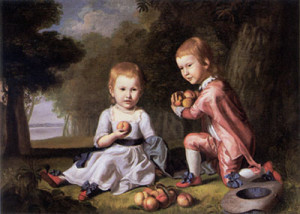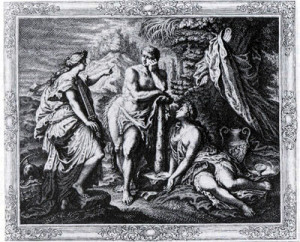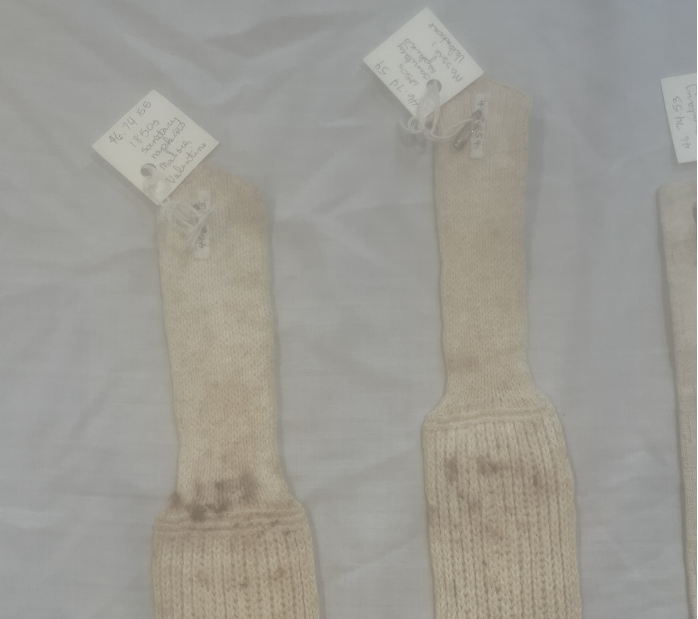When Charles Willson Peale painted a portrait for fellow Annapolis resident Anthony Stewart, he tailored it to his patron in ways besides including likenesses of Stewart’s son, John, and daughter, Isabella (fig. 1). Although the setting is not a cultivated part of a plantation like Mount Stewart–the elder Stewart’s property on Maryland’s Eastern Shore–the depiction of peaches on the ground near a body of water evokes that property and its bounty. The thistle at far right signifies the Scottish-born Stewart’s ancestry, that plant being Scotland’s national emblem. Yet of the aspects of the portrait fitted to its patron, the most remarkable is the way that its story invited him to contemplate an immoral orientation towards property acquisition. What are likely to have been Peale’s beliefs about Stewart’s character and deeds apparently inspired the painter to foster this experience, one with a foundation in a widely available, if rarely used idea about what portraits can do.
I.
Of the many figures in eighteenth-century British and colonial American double portraits pairing a brother and sister, John Stewart may be the only one who works. His characterization is ambivalent. From one vantage, he displays an admirable industriousness. He carries four peaches, as many as his diminutive arms can hold. With eight peaches already where Isabella has planted herself, this is apparently John’s third haul. (Isabella’s long, trailing drapery suggests her disengagement from labor.) From another vantage, however, John courts dishonor as he nears the point of gathering more than he and his sister can eat. According to a famous discussion in John Locke’s Two Treatises of Government, property came about by a man adding his labor to nature, but “if [nature’s products] perished in his possession without their due use . . . he offended against the common law of nature and was liable to be punished.” Locke added that such action on a man’s part “invaded his neighbor’s share, for he had no right [to products] further than his use called for any of them.” Connoting avarice, the depicted John’s actions are also vulnerable from Christian and secular vantages. His visible hand characterizes him as grasping. Yet the way that John turns his head to look at the peach Isabella holds opens the possibility that he might not overstock. (Aligned with her arm, dress contour, and shoe, his gaze is a prominent, integral part of the composition.) John’s interest in the fruit can be readily accounted for when considered from Isabella’s vantage. It is almost obvious what goes through the mind of a female, alone with a male in nature, who holds a fruit poised for the biting but not yet eaten.
II.
Peale planned this portrait to invoke the moment in sacred history just before Eve ate the forbidden fruit. That the Stewarts’ fruit is a peach would not have misled an eighteenth-century viewer; Genesis and Milton both describe the fruit of the tree of the knowledge of good and evil without mentioning apples. Not only did this event mark the origin of mankind as fallen, but Milton’s account of it fostered Peale’s origin as a painter since he based his first oil painting on a related engraving from an illustrated edition of Paradise Lost. The Fall humbles most everything John does. His working is a legacy of Adam, condemned to labor. His collecting food contrasts with how man and woman in Eden had no need to gather or store. Clothes, too, are badges of sin. John’s cape, breeches, bows, lace collar, and cuffs derive from portraits by Antony Van Dyke, painter to England’s royalty and aristocrats. Yet these fancy threads ill befit John’s activity. Adam was to labor by the sweat of his brow, and John has already removed his hat. How many more trips can he make before he spoils the splendid garments that are to promote him as a young gentleman? Peale structured The Stewart Children to foster the idea that John thinks about the past; he and his sister are Adam and Eve’s children as much as they are those first parents’ analogues. Yet the painting also promotes the idea that he contemplates various moments in the future: he can see that Isabella will eat presently; ruining his clothes looms ahead; and he has the opportunity to think about whether he will develop a moral relationship to property. Although looking at the peach just slows him down at present, the perpetual present of the scene encourages considering this change of pace as a principle. His attention to the peach, which ultimately fosters recognizing the link between his acquisitiveness and sin, thus implies a future characterized by restraint. With its exaggeration of the children’s heads, the painting offers a strong invitation to consider what they think. Moreover, it will be a rare viewer who can avoid considering his or her own attitudes while following this train of associations. The unique public profile of the children’s father helps to explain what motivated Peale to create such extraordinary characterizations of them, and to spur such a striking series of thoughts.
III.
Anthony Stewart was among the busiest merchants of Annapolis during the early 1770s. Times had been challenging for merchants, due in part to periods of nonimportation that pressured England while the Stamp, Townshend, and Tea Acts were in effect. Every step of the way, Stewart challenged the local moral economy, a force that historian E. P. Thompson has described as “a consistent traditional view of social norms and obligations, of the proper economic functions of several parties within the community.” Nonimportation was a mass legitimated expression of colonial grievance, and to violate it was to invite reprisal. Stewart defied nonimportation in 1770, he lost an election bid in 1773 because “a strong suspicion was entertained of his political principles and court connexions,” and the arrival of his tea-laden ship in October 1774 violated a boycott. People wanted him to send the tea back; some threatened his family with harm. As if pressured by the mob, he set his laden ship ablaze. The year before, Boston rebels had also destroyed tea, but in 1774 Annapolis “out-Bostoned Boston.” Some even thought that Stewart was well pleased with the affair’s hardly necessary climax. He stood £12,000 in debt by mid-1774, and stood to rectify his affairs if, as victim of a Patriot mob, he could get the English government to reimburse him for his ship and cargo. Peale committed himself to nonimportation by 1768, and would have been among those who condemned the range of Stewart’s actions. The only evidence of contact between the men is the double portrait and its mention in a list of commissions. But Peale pondered Stewart’s misdeeds for decades to come: a painting of Stewart’s burning ship hung in his museum during the nineteenth century. To Annapolis’s Whigs, Stewart would be just the sort of person to benefit from a reoriented attitude towards property. His portrait of his children could promote that end. As a man who knew that others believed he harmed the common good with unprincipled strategies for profit, he could see an allegory of his relationship to property in this depiction of his son dangerously close to violating natural law and common beliefs about ownership. His religion supported this reception: the Anglican doctrine of Original Sin recognized divine laws that sought to restrain man from perpetrating the evil that his natural liberty freed him to do. For Peale’s vantage, the absence of evidence that his patron obeyed the social contract or the laws of nature about property accumulation gave him reason enough to paint a spur to principled behavior. He may have also thought Stewart likely be a bad example to his children, so the painting could do double duty filling a domestic moral vacuum. Depicted allusions to the family’s twin legacies–Original Sin, shared with all men, and a Scottish ancestry, by virtue of the depicted thistle–dovetailed with the painting’s lesson about attitudes towards property so as to enjoin right action. Both The Stewart Family’s allusion to the shame of the Stewarts’ first ancestors and its hint of pride in more recent ones could encourage behavior oriented toward a respectable familial future.
IV.
The sort of reception encouraged by Peale’s portrait had a precedent in Jonathan Richardson’s ideas about what portraits can do, first published in London in 1715. Discussing the ways that portraits affect viewers, that portrait painter and theorist speculated about sitters as viewers: “And why should we not also believe, that considering the violent thirst of praise which is natural, especially in the noblest minds, and the better sort of people, they that see their pictures are set up as monuments of good or evil fame, are often secretly admonished by the faithful friend in their own breasts, to add new graces to them by praise-worthy actions, and to avoid blemishes . . . as much as possible, by a future good conduct.” While positive exempla fill the history of portraiture, negative ones are few. Who would want one? By covering a canvas with readily noted signs of wealth, ancestry, and material splendor, Peale slipped one into his patron’s home. Moreover, Peale innovated beyond what Richardson described. He did not depict a static monument of “evil fame,” but a dynamic moment when a vicious trajectory may be coming to a halt. The principle underlying this lesson was well known from Locke’s Thoughts Concerning Education of 1693. Locke emphasized withholding approval as a powerful tool for bringing young people in line with an elder’s expectations. In his late autobiography, Peale endorsed this method of child rearing: “Shame, if properly seasoned, is a greater scourge than the Birch.” A major model of human identity positioned between an older theory of innate, transmitted depravity (which endorsed corporeal punishment as a means of control), and Rousseau’s ideas about man freely expressing his natural inclinations, Locke’s understanding embraced the role of conscience in prompting good behavior. This is the faculty Richardson referred to as “the faithful friend in [the sitters’] own breasts” that would motivate them to “future good conduct” when viewing portraits that showed them in a bad light.
In the case of the depicted John Stewart, the sight of the fruit and its association with the Fall stop him short and cause him to reflect on what he has been doing. The Scottish common sense school had analyzed conscience, which they called “the moral sense,” into components of will and understanding, and this vocabulary offers a concise way to describe what John is doing: he seeks to reconcile the two. As much as the labor of the body, he pursues the labor of conscience. Whereas The Stewart Children had few pictorial precedents on the matter of negative exempla, a bounty of pictures represented choices being made. Most ubiquitously, engravings of The Judgment of Hercules represented an ancient story about Hercules deciding between Virtue and Vice (fig. 2). Whereas figures to either side of Hercules embody the alternatives he confronts, viewers of John Stewart must infer his less tangible alternatives. Crucially, no prior text scripts what he will decide. Nonetheless, his process offers the prospect of a choice to stem rapacity.
V.
The Stewart Children instances passionately held ideas about the common welfare structuring a painting that sought to have a moral and social impact on viewers. As an expression of the Annapolis moral economy, it positioned itself alongside the day’s verbal criticism of Stewart to resist the mounting forces of economic modernity. It is a rare and curious piece of property that pressures owners to exercise restraint with respect to accumulation. If the portrait did not work on the elder Stewart, then perhaps it would affect his son. Certainly many people in his family have thought it worth looking at. Anthony Stewart fled Annapolis in early 1775. When following him, first to Halifax and then to England, family members brought the portrait along. It descended through the Stewart line some two hundred years before entering the art market.
Further Reading:
Perhaps the most useful discussions of The Stewart Children to date are Elizabeth Garrity Ellis, “The Stewart Children (Isabella and John Stewart),” in Barbara Novak, ed., The Thyssen-Bornemisza Collection: Nineteenth-century American Painting (London, 1986), 56-57; and Regine Kahl, “Charles Willson Peale, Isabella und John Stewart,” in Bilder aus der Neuen Welt: Amerikanische Malerei des 18. und 19. Jahrhunderts (Munich, 1988), cat. no. 5. John Locke’s discussion of private property was chapter 5 of the second of his Two Treatises of Government, Peter Laslett, ed. (Cambridge, 1967), quote at 313. Peale recalled his early painting of Adam and Eve, and wrote about the power of shame in his late autobiography (1825-26); Lillian B. Miller, Sidney Hart, and David C. Ward, eds., The Selected Papers of Charles Willson Peale and His Family, 5 vols. (New Haven, 2000), 5: 15, 10. The best discussion of Anthony Stewart and the Peggy Stewart affair is Ronald Hoffman, A Spirit of Dissension: Economics, Politics, and the Revolution in Maryland (Baltimore and London, 1973), 134-39; Arthur Meier Schlesinger, The Colonial Merchants and the American Revolution, 1763-1776 (New York, 1918), 388-92, offers an alternative analysis, and is the source for the phrase comparing events in Annapolis and Boston. The Maryland Gazette, May 20, 1773, speculated why Stewart lost his election bid. Peale’s early list of commissions is reproduced in Charles Coleman Sellers, “Portraits and Miniatures by Charles Willson Peale,”Transactions of the American Philosophical Society, 42(1) (1952), 20. Historical Catalogue of the Paintings in the Philadelphia Museum, consisting chiefly of Portraits of Revolutionary Patriots and other Distinguished Characters (Philadelphia, 1813), 54, describes the painting of the burning of the Peggy Stewart. E. P. Thompson introduced the concept of a moral economy in “The Moral Economy of the Crowd in Eighteenth-Century England,” Past and Present 50 (February 1971): 76-136, quoted at 79; Jane T. Merritt, “Tea Traders and the Ambivalent American Moral Economy,” (paper presented at the McNeil Center for Early American Studies, April 25, 2003), has applied this concept with considerable subtlety to the colonial controversy over tea importation. Jonathan Richardson first published his thoughts on portrait functions in “A Theory of Painting” (1715), which subsequently appeared in The Works of Mr. Jonathan Richardson (1773; rpt. Hildesheim, 1969), 7-8. The key discussion of the significance of Locke’s Some Thoughts Concerning Education for American readers is Jay Fliegelman, Prodigals and Pilgrims: The American Revolution against Patriarchal Authority, 1750-1800 (Cambridge, 1984), which places Locke in the context of developing attitudes towards child rearing. James Christen Steward, The New Child: British Art and the Origins of Modern Childhood, 1730-1830 (Berkeley, 1995) surveys the relationships between portraits of, and changing ideas about, children. Daniel Walker Howe, Making the American Self: Jonathan Edwards to Abraham Lincoln (Cambridge and London, 1997) offers a very informed discussion of conscience in faculty psychology. My “The Work of Autobiography and the Workings of Conscience,” (review of Lillian B. Miller, ed., The Selected Papers of Charles Willson Peale and his Family. Volume 4: Charles Willson Peale: His Last Years, 1821-1827; Lillian B. Miller and Sidney Hart, eds. Volume 5: The Autobiography of Charles Willson Peale (New Haven and London: Yale University Press, 1996, 2000) in William and Mary Quarterly (April 2001): 498-505, examines some of Peale’s discussions of conscience, and considers how that faculty shaped a part of his late autobiography.
This article originally appeared in issue 4.3 (April, 2004).
David Steinberg is a visiting scholar at the Omohundro Institute of Early American History and Culture. He is co-author of Transformations in Cleveland Art, 1796-1946 (Cleveland, 1996), and author of the forthcoming Portrait as Instrument: Late Colonial Ends & Early Charles Willson Peale.





















